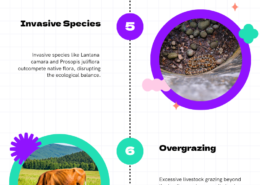How can India capitalize on its greatest asset, the demographic dividend?
India’s natural vegetation is incredibly diverse, but it faces several significant threats. Here are the major threats to vegetation in India, which you can use to create an infographic: 1. Deforestation Causes: Logging, agriculture, urbanization, and infrastructure development. Impact: Loss of habiRead more
India’s natural vegetation is incredibly diverse, but it faces several significant threats. Here are the major threats to vegetation in India, which you can use to create an infographic:
1. Deforestation
- Causes: Logging, agriculture, urbanization, and infrastructure development.
- Impact: Loss of habitat, reduction in biodiversity, and disruption of ecosystems.
2. Urbanization
- Causes: Expansion of cities and towns.
- Impact: Conversion of natural landscapes into urban areas, leading to habitat fragmentation and loss.
3. Pollution
- Causes: Industrial activities, vehicular emissions, and agricultural runoff.
- Impact: Soil degradation, water contamination, and adverse effects on plant health.
4. Climate Change
- Causes: Global warming, changes in precipitation patterns, and extreme weather events.
- Impact: Altered growth patterns, increased vulnerability to pests and diseases, and shifts in vegetation zones.
5. Invasive Species
- Examples: Lantana camara, Chromolaena odorata, and Prosopis juliflora.
- Impact: Competition with native species, alteration of habitats, and disruption of ecological balance.
6. Overgrazing
- Causes: Livestock grazing beyond the carrying capacity of the land.
- Impact: Soil erosion, loss of plant cover, and degradation of grasslands.
7. Mining
- Causes: Extraction of minerals and resources.
- Impact: Destruction of vegetation, soil erosion, and pollution of water bodies.
8. Overexploitation
- Causes: Unsustainable harvesting of timber, medicinal plants, and other forest products.
- Impact: Depletion of resources and loss of biodiversity.
9. Habitat Destruction
- Causes: Infrastructure projects, agriculture, and human settlements.
- Impact: Loss of natural habitats, fragmentation, and decline in wildlife populations.
10. Decline of Pollinators
- Causes: Pesticide use, habitat loss, and climate change.
- Impact: Reduced pollination, affecting plant reproduction and crop yields.
These threats collectively pose a significant challenge to the conservation of India’s natural vegetation. Addressing these issues requires coordinated efforts in conservation, sustainable practices, and policy implementation.
See less



India's demographic dividend, characterized by a substantial working-age population, provides a unique opportunity for significant economic growth. To harness this potential, India must prioritize enhancing education and skill development, ensuring that the youth are equipped with the skills neededRead more
India’s demographic dividend, characterized by a substantial working-age population, provides a unique opportunity for significant economic growth. To harness this potential, India must prioritize enhancing education and skill development, ensuring that the youth are equipped with the skills needed in the evolving job market. Improving access to healthcare services is equally vital, as a healthy workforce is more productive and less burdened by healthcare costs. Creating job opportunities and fostering entrepreneurship are crucial strategies, supported by policies that encourage small businesses and startups. Additionally, modernizing labor laws can enhance job satisfaction and productivity by ensuring a balanced approach to flexibility and worker protection. Investment in infrastructure, particularly in developing smart cities and improving transportation and housing, is essential for supporting urbanization and improving living standards. By focusing on these areas, India can effectively leverage its demographic dividend, paving the way for sustained economic development and prosperity.
See less